SSHA Project Investment Analysis - ACC211 Finance, Booli Electronics
VerifiedAdded on 2023/06/12
|11
|2298
|123
Report
AI Summary
This report provides a comprehensive financial analysis of Booli Electronics' proposed investment in a new 'smart speaker and home assistant' (SSHA) model. It includes calculations of the non-discounted payback period (2.14 years), profitability index (1.65), internal rate of return (19.77%), and net present value ($30,548,881.43). Sensitivity analyses are conducted to assess the impact of price and quantity changes on the NPV, revealing that NPV is highly sensitive to price changes and moderately sensitive to quantity changes. The report concludes that Booli Enterprise should accept the project due to the positive NPV, favorable profitability index and reasonable payback period and IRR. It recommends considering potential losses from other products when evaluating the investment to ensure the project's overall viability.

Running head: BUSINESS FINANCE
Business finance
Name of the student
Name of the university
Student ID
Author note
Business finance
Name of the student
Name of the university
Student ID
Author note
Paraphrase This Document
Need a fresh take? Get an instant paraphrase of this document with our AI Paraphraser
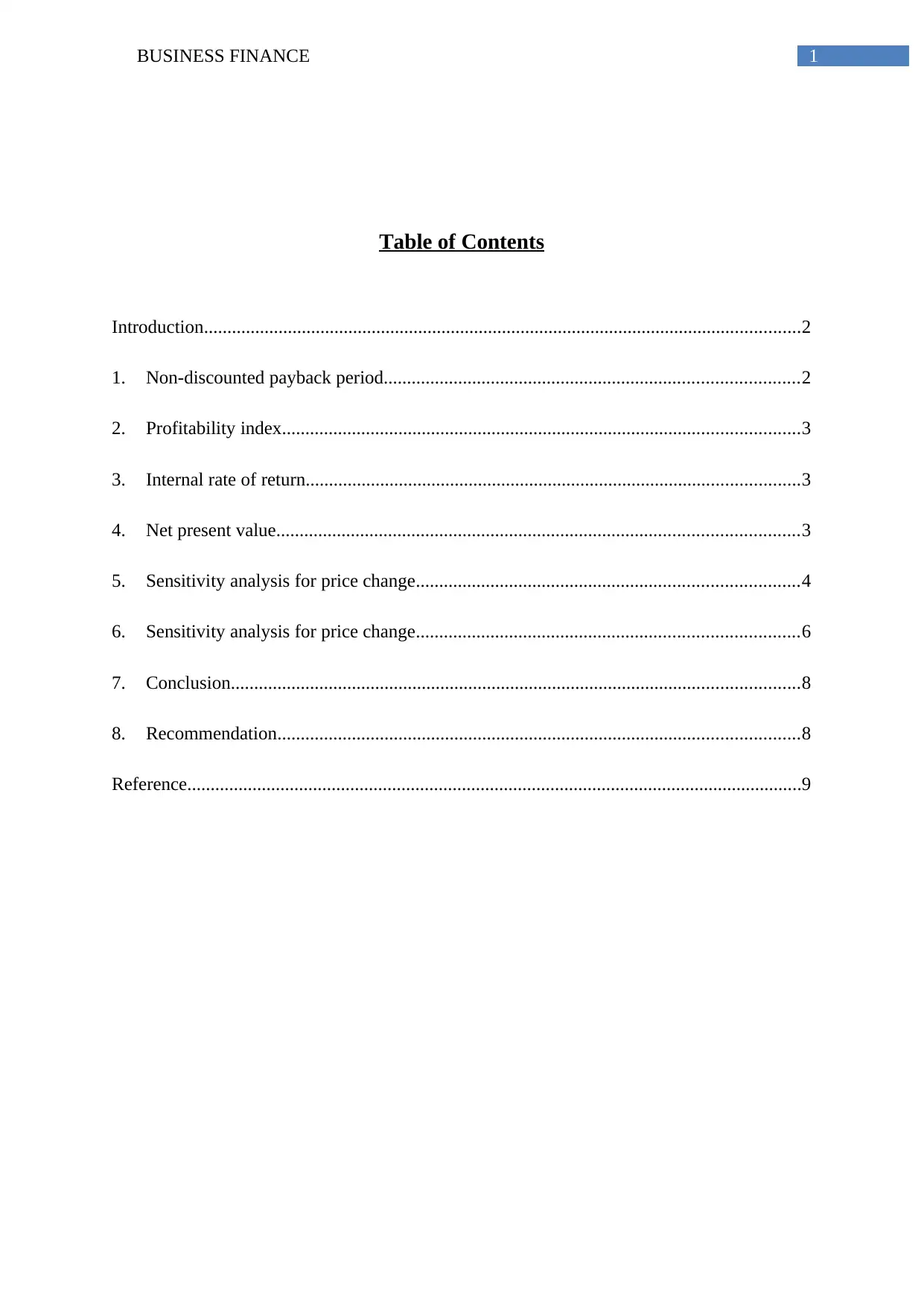
1BUSINESS FINANCE
Table of Contents
Introduction................................................................................................................................2
1. Non-discounted payback period.........................................................................................2
2. Profitability index...............................................................................................................3
3. Internal rate of return..........................................................................................................3
4. Net present value................................................................................................................3
5. Sensitivity analysis for price change..................................................................................4
6. Sensitivity analysis for price change..................................................................................6
7. Conclusion..........................................................................................................................8
8. Recommendation................................................................................................................8
Reference....................................................................................................................................9
Table of Contents
Introduction................................................................................................................................2
1. Non-discounted payback period.........................................................................................2
2. Profitability index...............................................................................................................3
3. Internal rate of return..........................................................................................................3
4. Net present value................................................................................................................3
5. Sensitivity analysis for price change..................................................................................4
6. Sensitivity analysis for price change..................................................................................6
7. Conclusion..........................................................................................................................8
8. Recommendation................................................................................................................8
Reference....................................................................................................................................9
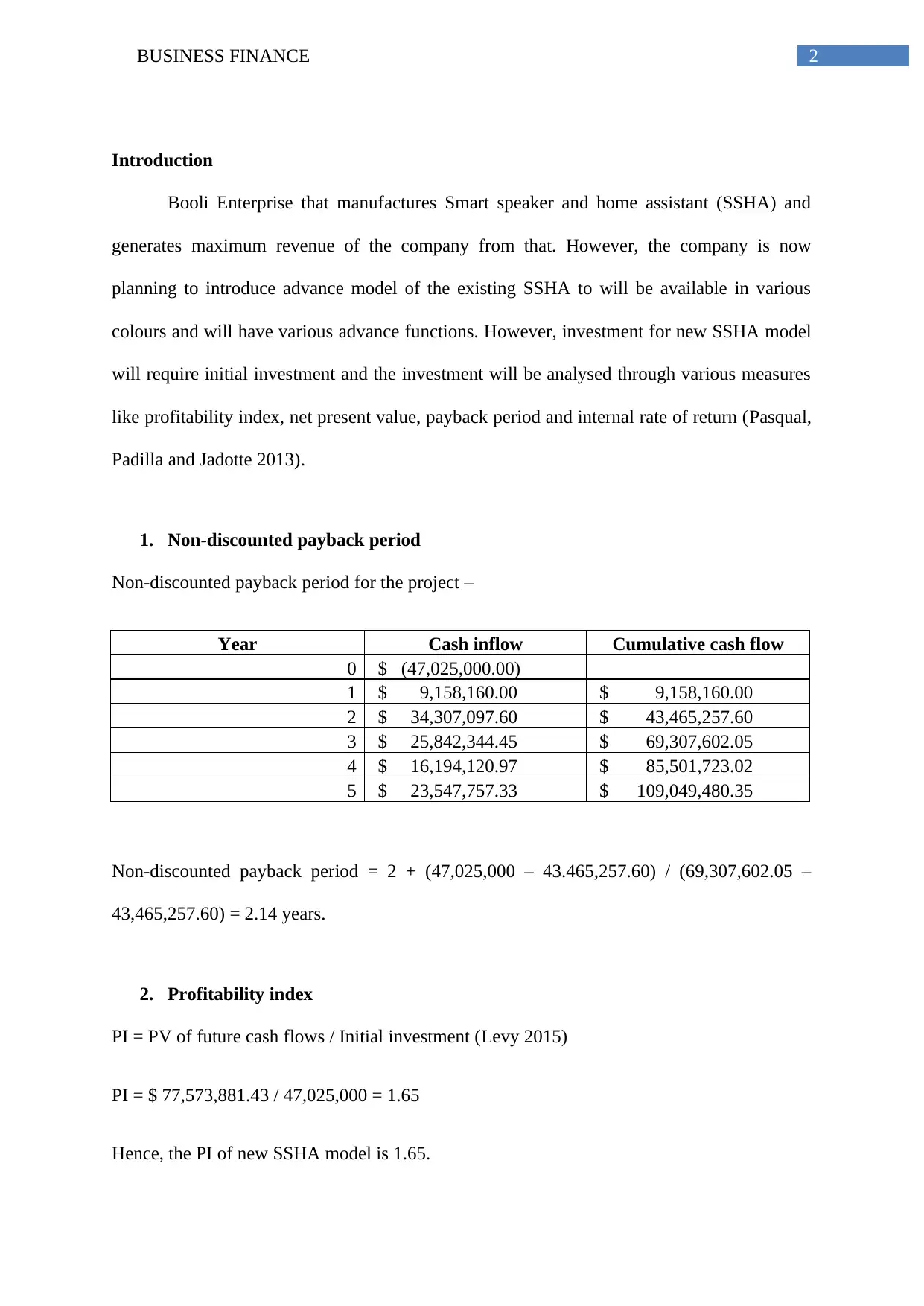
2BUSINESS FINANCE
Introduction
Booli Enterprise that manufactures Smart speaker and home assistant (SSHA) and
generates maximum revenue of the company from that. However, the company is now
planning to introduce advance model of the existing SSHA to will be available in various
colours and will have various advance functions. However, investment for new SSHA model
will require initial investment and the investment will be analysed through various measures
like profitability index, net present value, payback period and internal rate of return (Pasqual,
Padilla and Jadotte 2013).
1. Non-discounted payback period
Non-discounted payback period for the project –
Year Cash inflow Cumulative cash flow
0 $ (47,025,000.00)
1 $ 9,158,160.00 $ 9,158,160.00
2 $ 34,307,097.60 $ 43,465,257.60
3 $ 25,842,344.45 $ 69,307,602.05
4 $ 16,194,120.97 $ 85,501,723.02
5 $ 23,547,757.33 $ 109,049,480.35
Non-discounted payback period = 2 + (47,025,000 – 43.465,257.60) / (69,307,602.05 –
43,465,257.60) = 2.14 years.
2. Profitability index
PI = PV of future cash flows / Initial investment (Levy 2015)
PI = $ 77,573,881.43 / 47,025,000 = 1.65
Hence, the PI of new SSHA model is 1.65.
Introduction
Booli Enterprise that manufactures Smart speaker and home assistant (SSHA) and
generates maximum revenue of the company from that. However, the company is now
planning to introduce advance model of the existing SSHA to will be available in various
colours and will have various advance functions. However, investment for new SSHA model
will require initial investment and the investment will be analysed through various measures
like profitability index, net present value, payback period and internal rate of return (Pasqual,
Padilla and Jadotte 2013).
1. Non-discounted payback period
Non-discounted payback period for the project –
Year Cash inflow Cumulative cash flow
0 $ (47,025,000.00)
1 $ 9,158,160.00 $ 9,158,160.00
2 $ 34,307,097.60 $ 43,465,257.60
3 $ 25,842,344.45 $ 69,307,602.05
4 $ 16,194,120.97 $ 85,501,723.02
5 $ 23,547,757.33 $ 109,049,480.35
Non-discounted payback period = 2 + (47,025,000 – 43.465,257.60) / (69,307,602.05 –
43,465,257.60) = 2.14 years.
2. Profitability index
PI = PV of future cash flows / Initial investment (Levy 2015)
PI = $ 77,573,881.43 / 47,025,000 = 1.65
Hence, the PI of new SSHA model is 1.65.
⊘ This is a preview!⊘
Do you want full access?
Subscribe today to unlock all pages.

Trusted by 1+ million students worldwide
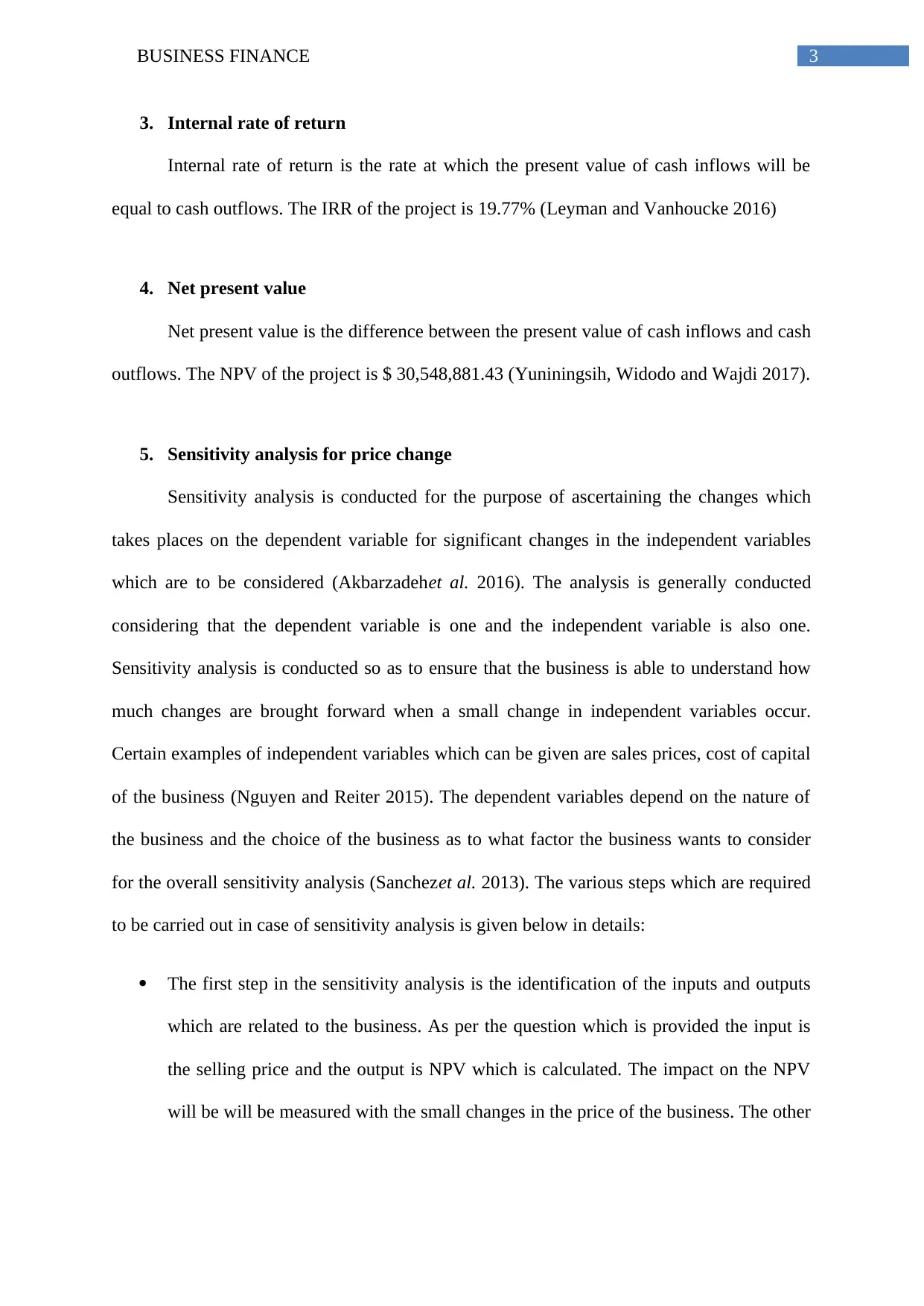
3BUSINESS FINANCE
3. Internal rate of return
Internal rate of return is the rate at which the present value of cash inflows will be
equal to cash outflows. The IRR of the project is 19.77% (Leyman and Vanhoucke 2016)
4. Net present value
Net present value is the difference between the present value of cash inflows and cash
outflows. The NPV of the project is $ 30,548,881.43 (Yuniningsih, Widodo and Wajdi 2017).
5. Sensitivity analysis for price change
Sensitivity analysis is conducted for the purpose of ascertaining the changes which
takes places on the dependent variable for significant changes in the independent variables
which are to be considered (Akbarzadehet al. 2016). The analysis is generally conducted
considering that the dependent variable is one and the independent variable is also one.
Sensitivity analysis is conducted so as to ensure that the business is able to understand how
much changes are brought forward when a small change in independent variables occur.
Certain examples of independent variables which can be given are sales prices, cost of capital
of the business (Nguyen and Reiter 2015). The dependent variables depend on the nature of
the business and the choice of the business as to what factor the business wants to consider
for the overall sensitivity analysis (Sanchezet al. 2013). The various steps which are required
to be carried out in case of sensitivity analysis is given below in details:
The first step in the sensitivity analysis is the identification of the inputs and outputs
which are related to the business. As per the question which is provided the input is
the selling price and the output is NPV which is calculated. The impact on the NPV
will be will be measured with the small changes in the price of the business. The other
3. Internal rate of return
Internal rate of return is the rate at which the present value of cash inflows will be
equal to cash outflows. The IRR of the project is 19.77% (Leyman and Vanhoucke 2016)
4. Net present value
Net present value is the difference between the present value of cash inflows and cash
outflows. The NPV of the project is $ 30,548,881.43 (Yuniningsih, Widodo and Wajdi 2017).
5. Sensitivity analysis for price change
Sensitivity analysis is conducted for the purpose of ascertaining the changes which
takes places on the dependent variable for significant changes in the independent variables
which are to be considered (Akbarzadehet al. 2016). The analysis is generally conducted
considering that the dependent variable is one and the independent variable is also one.
Sensitivity analysis is conducted so as to ensure that the business is able to understand how
much changes are brought forward when a small change in independent variables occur.
Certain examples of independent variables which can be given are sales prices, cost of capital
of the business (Nguyen and Reiter 2015). The dependent variables depend on the nature of
the business and the choice of the business as to what factor the business wants to consider
for the overall sensitivity analysis (Sanchezet al. 2013). The various steps which are required
to be carried out in case of sensitivity analysis is given below in details:
The first step in the sensitivity analysis is the identification of the inputs and outputs
which are related to the business. As per the question which is provided the input is
the selling price and the output is NPV which is calculated. The impact on the NPV
will be will be measured with the small changes in the price of the business. The other
Paraphrase This Document
Need a fresh take? Get an instant paraphrase of this document with our AI Paraphraser
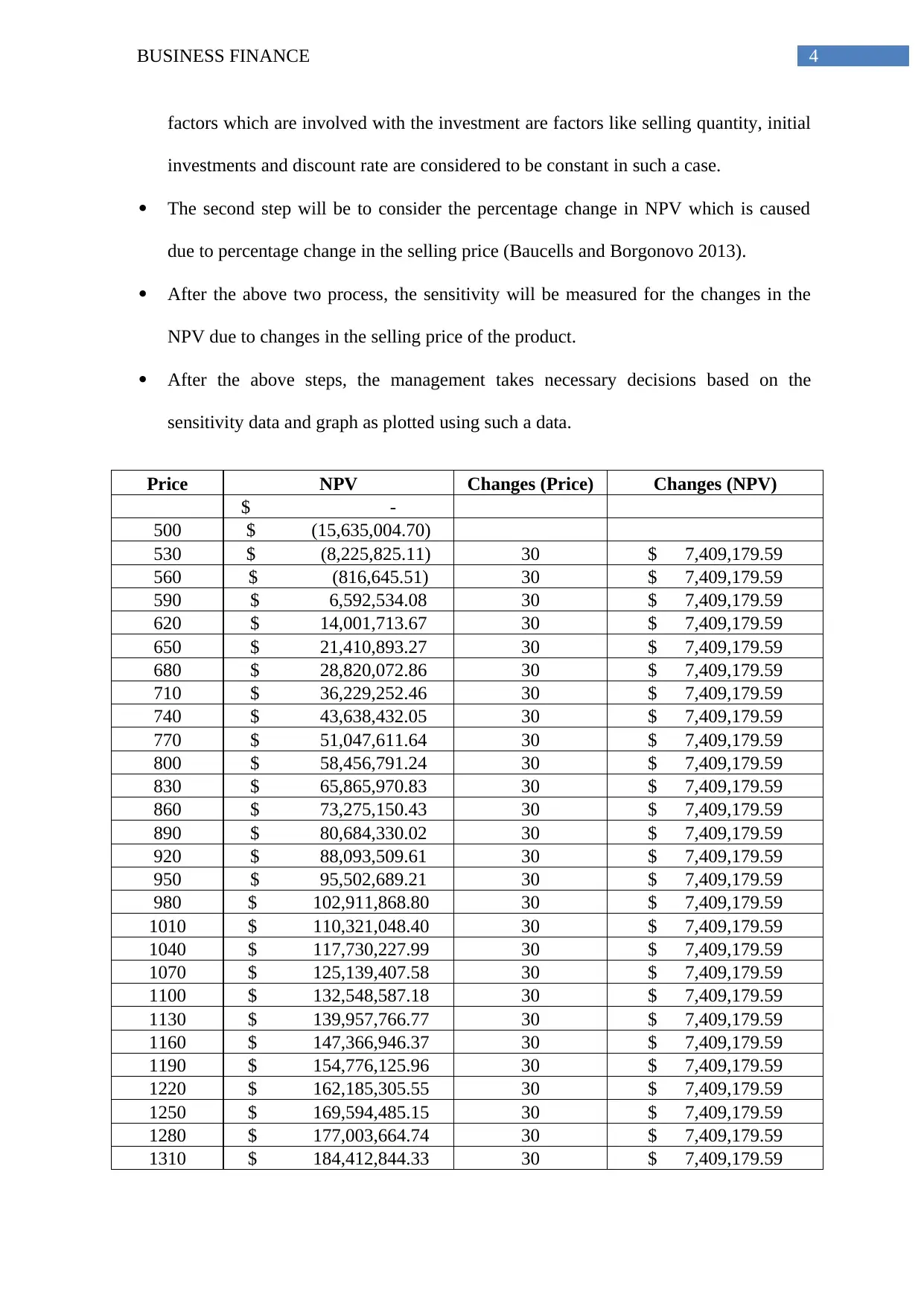
4BUSINESS FINANCE
factors which are involved with the investment are factors like selling quantity, initial
investments and discount rate are considered to be constant in such a case.
The second step will be to consider the percentage change in NPV which is caused
due to percentage change in the selling price (Baucells and Borgonovo 2013).
After the above two process, the sensitivity will be measured for the changes in the
NPV due to changes in the selling price of the product.
After the above steps, the management takes necessary decisions based on the
sensitivity data and graph as plotted using such a data.
Price NPV Changes (Price) Changes (NPV)
$ -
500 $ (15,635,004.70)
530 $ (8,225,825.11) 30 $ 7,409,179.59
560 $ (816,645.51) 30 $ 7,409,179.59
590 $ 6,592,534.08 30 $ 7,409,179.59
620 $ 14,001,713.67 30 $ 7,409,179.59
650 $ 21,410,893.27 30 $ 7,409,179.59
680 $ 28,820,072.86 30 $ 7,409,179.59
710 $ 36,229,252.46 30 $ 7,409,179.59
740 $ 43,638,432.05 30 $ 7,409,179.59
770 $ 51,047,611.64 30 $ 7,409,179.59
800 $ 58,456,791.24 30 $ 7,409,179.59
830 $ 65,865,970.83 30 $ 7,409,179.59
860 $ 73,275,150.43 30 $ 7,409,179.59
890 $ 80,684,330.02 30 $ 7,409,179.59
920 $ 88,093,509.61 30 $ 7,409,179.59
950 $ 95,502,689.21 30 $ 7,409,179.59
980 $ 102,911,868.80 30 $ 7,409,179.59
1010 $ 110,321,048.40 30 $ 7,409,179.59
1040 $ 117,730,227.99 30 $ 7,409,179.59
1070 $ 125,139,407.58 30 $ 7,409,179.59
1100 $ 132,548,587.18 30 $ 7,409,179.59
1130 $ 139,957,766.77 30 $ 7,409,179.59
1160 $ 147,366,946.37 30 $ 7,409,179.59
1190 $ 154,776,125.96 30 $ 7,409,179.59
1220 $ 162,185,305.55 30 $ 7,409,179.59
1250 $ 169,594,485.15 30 $ 7,409,179.59
1280 $ 177,003,664.74 30 $ 7,409,179.59
1310 $ 184,412,844.33 30 $ 7,409,179.59
factors which are involved with the investment are factors like selling quantity, initial
investments and discount rate are considered to be constant in such a case.
The second step will be to consider the percentage change in NPV which is caused
due to percentage change in the selling price (Baucells and Borgonovo 2013).
After the above two process, the sensitivity will be measured for the changes in the
NPV due to changes in the selling price of the product.
After the above steps, the management takes necessary decisions based on the
sensitivity data and graph as plotted using such a data.
Price NPV Changes (Price) Changes (NPV)
$ -
500 $ (15,635,004.70)
530 $ (8,225,825.11) 30 $ 7,409,179.59
560 $ (816,645.51) 30 $ 7,409,179.59
590 $ 6,592,534.08 30 $ 7,409,179.59
620 $ 14,001,713.67 30 $ 7,409,179.59
650 $ 21,410,893.27 30 $ 7,409,179.59
680 $ 28,820,072.86 30 $ 7,409,179.59
710 $ 36,229,252.46 30 $ 7,409,179.59
740 $ 43,638,432.05 30 $ 7,409,179.59
770 $ 51,047,611.64 30 $ 7,409,179.59
800 $ 58,456,791.24 30 $ 7,409,179.59
830 $ 65,865,970.83 30 $ 7,409,179.59
860 $ 73,275,150.43 30 $ 7,409,179.59
890 $ 80,684,330.02 30 $ 7,409,179.59
920 $ 88,093,509.61 30 $ 7,409,179.59
950 $ 95,502,689.21 30 $ 7,409,179.59
980 $ 102,911,868.80 30 $ 7,409,179.59
1010 $ 110,321,048.40 30 $ 7,409,179.59
1040 $ 117,730,227.99 30 $ 7,409,179.59
1070 $ 125,139,407.58 30 $ 7,409,179.59
1100 $ 132,548,587.18 30 $ 7,409,179.59
1130 $ 139,957,766.77 30 $ 7,409,179.59
1160 $ 147,366,946.37 30 $ 7,409,179.59
1190 $ 154,776,125.96 30 $ 7,409,179.59
1220 $ 162,185,305.55 30 $ 7,409,179.59
1250 $ 169,594,485.15 30 $ 7,409,179.59
1280 $ 177,003,664.74 30 $ 7,409,179.59
1310 $ 184,412,844.33 30 $ 7,409,179.59
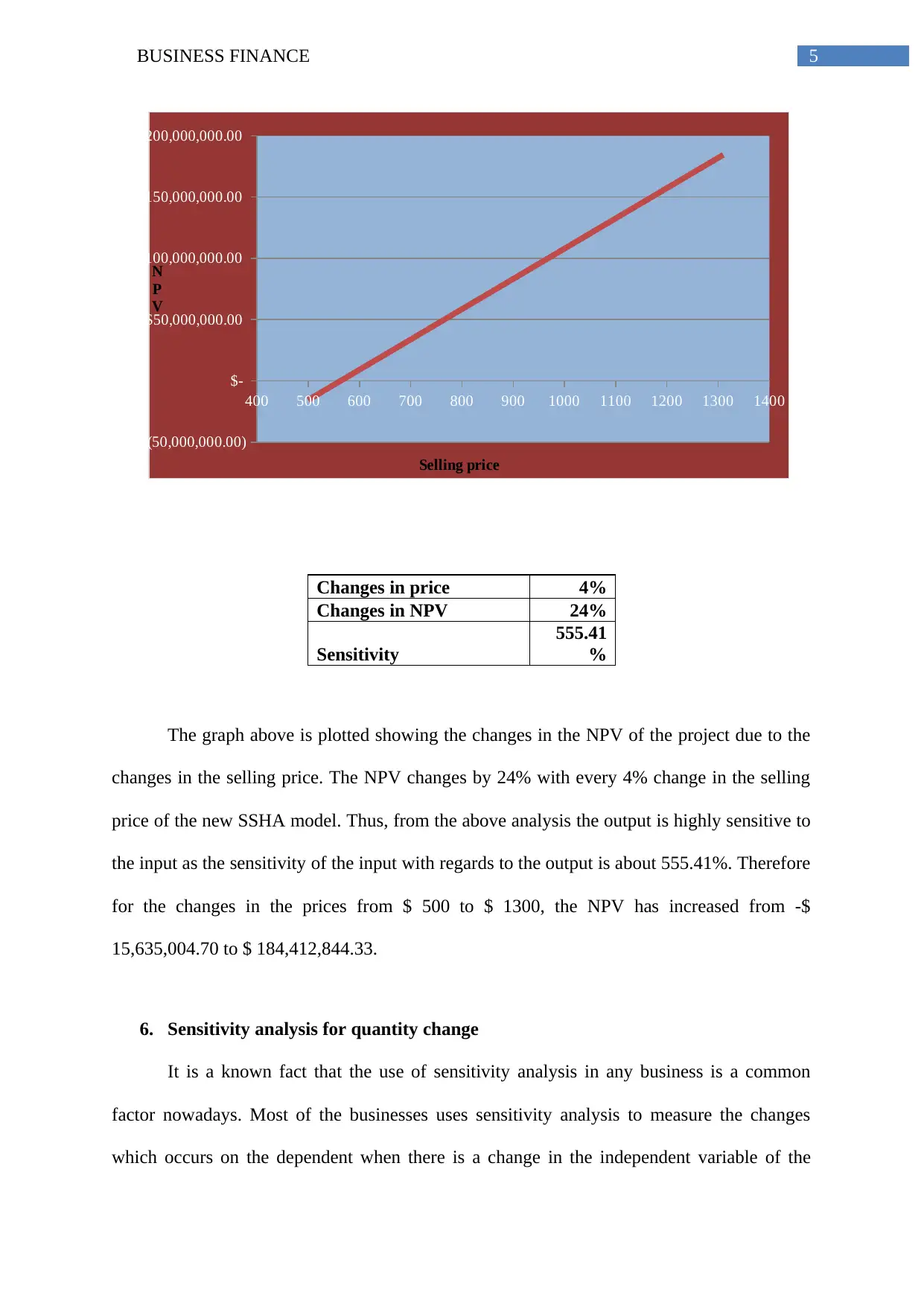
5BUSINESS FINANCE
400 500 600 700 800 900 1000 1100 1200 1300 1400
$(50,000,000.00)
$-
$50,000,000.00
$100,000,000.00
$150,000,000.00
$200,000,000.00
Selling price
N
P
V
Changes in price 4%
Changes in NPV 24%
Sensitivity
555.41
%
The graph above is plotted showing the changes in the NPV of the project due to the
changes in the selling price. The NPV changes by 24% with every 4% change in the selling
price of the new SSHA model. Thus, from the above analysis the output is highly sensitive to
the input as the sensitivity of the input with regards to the output is about 555.41%. Therefore
for the changes in the prices from $ 500 to $ 1300, the NPV has increased from -$
15,635,004.70 to $ 184,412,844.33.
6. Sensitivity analysis for quantity change
It is a known fact that the use of sensitivity analysis in any business is a common
factor nowadays. Most of the businesses uses sensitivity analysis to measure the changes
which occurs on the dependent when there is a change in the independent variable of the
400 500 600 700 800 900 1000 1100 1200 1300 1400
$(50,000,000.00)
$-
$50,000,000.00
$100,000,000.00
$150,000,000.00
$200,000,000.00
Selling price
N
P
V
Changes in price 4%
Changes in NPV 24%
Sensitivity
555.41
%
The graph above is plotted showing the changes in the NPV of the project due to the
changes in the selling price. The NPV changes by 24% with every 4% change in the selling
price of the new SSHA model. Thus, from the above analysis the output is highly sensitive to
the input as the sensitivity of the input with regards to the output is about 555.41%. Therefore
for the changes in the prices from $ 500 to $ 1300, the NPV has increased from -$
15,635,004.70 to $ 184,412,844.33.
6. Sensitivity analysis for quantity change
It is a known fact that the use of sensitivity analysis in any business is a common
factor nowadays. Most of the businesses uses sensitivity analysis to measure the changes
which occurs on the dependent when there is a change in the independent variable of the
⊘ This is a preview!⊘
Do you want full access?
Subscribe today to unlock all pages.

Trusted by 1+ million students worldwide

6BUSINESS FINANCE
business (Tian 2013). The method is useful for establishing a relationship between the
independent and dependent variable which the business is considering. Such dependent and
independent variable can be anything such as NPV and selling price of the product. The
various steps which can be suggested for the purpose of conducting sensitivity analysis are
given below in point form:
In this case the input which is chosen by the business is the selling quantity and the
output that is to be considered is NPV. The changes in the NPV will be measured in
terms of the changes in the selling quantity of the product. The other factors which are
related to the project which can affect the analysis such as discount rate, initial
investments and selling price of the product are considered to be constant.
The percentage change in the NPV will be measured with respect to the percentage
change in the selling quantity of the product (Cucchiella, D’Adamo and Gastaldi
2015).
The NPV of the investment is to be then measured with the selling quantity and the
same is to be analyzed as well keeping in the that other factors remain constant
(Wang, Xia and Zhang 2014).
Then it is to be ascertained how the analysis of sensitivity of the project will be
affecting the business decision making process.
Sales volume NPV Changes (Quantity) Changes (NPV)
$ -
25000 $ 22,354,148.82
50000 $ 25,411,884.87 25000 3,057,736.05
75000 $ 28,469,620.92 25000 3,057,736.05
100000 $ 31,527,356.97 25000 3,057,736.05
125000 $ 34,585,093.02 25000 3,057,736.05
150000 $ 37,642,829.07 25000 3,057,736.05
175000 $ 40,700,565.12 25000 3,057,736.05
200000 $ 43,758,301.17 25000 3,057,736.05
225000 $ 46,816,037.22 25000 3,057,736.05
business (Tian 2013). The method is useful for establishing a relationship between the
independent and dependent variable which the business is considering. Such dependent and
independent variable can be anything such as NPV and selling price of the product. The
various steps which can be suggested for the purpose of conducting sensitivity analysis are
given below in point form:
In this case the input which is chosen by the business is the selling quantity and the
output that is to be considered is NPV. The changes in the NPV will be measured in
terms of the changes in the selling quantity of the product. The other factors which are
related to the project which can affect the analysis such as discount rate, initial
investments and selling price of the product are considered to be constant.
The percentage change in the NPV will be measured with respect to the percentage
change in the selling quantity of the product (Cucchiella, D’Adamo and Gastaldi
2015).
The NPV of the investment is to be then measured with the selling quantity and the
same is to be analyzed as well keeping in the that other factors remain constant
(Wang, Xia and Zhang 2014).
Then it is to be ascertained how the analysis of sensitivity of the project will be
affecting the business decision making process.
Sales volume NPV Changes (Quantity) Changes (NPV)
$ -
25000 $ 22,354,148.82
50000 $ 25,411,884.87 25000 3,057,736.05
75000 $ 28,469,620.92 25000 3,057,736.05
100000 $ 31,527,356.97 25000 3,057,736.05
125000 $ 34,585,093.02 25000 3,057,736.05
150000 $ 37,642,829.07 25000 3,057,736.05
175000 $ 40,700,565.12 25000 3,057,736.05
200000 $ 43,758,301.17 25000 3,057,736.05
225000 $ 46,816,037.22 25000 3,057,736.05
Paraphrase This Document
Need a fresh take? Get an instant paraphrase of this document with our AI Paraphraser
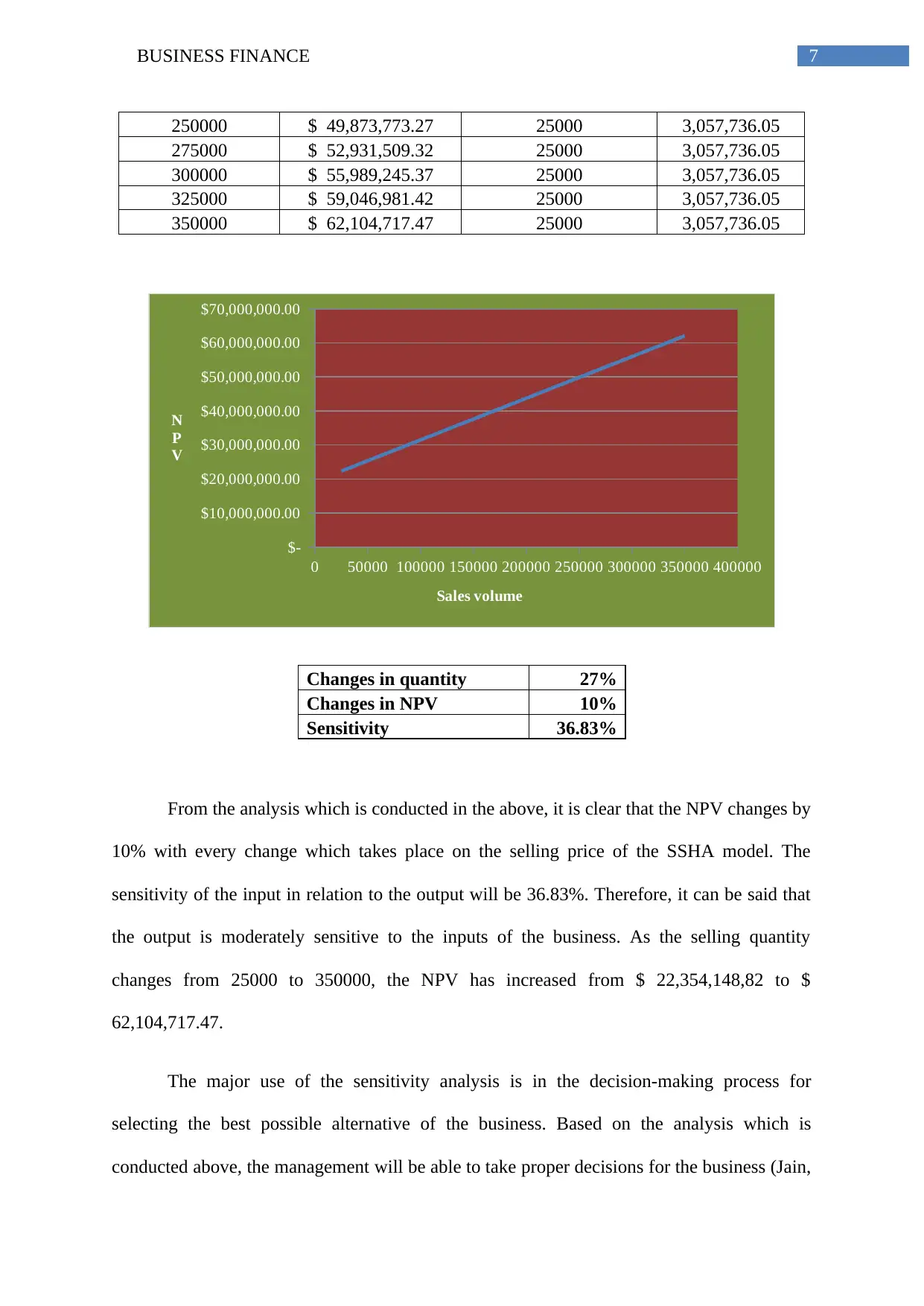
7BUSINESS FINANCE
250000 $ 49,873,773.27 25000 3,057,736.05
275000 $ 52,931,509.32 25000 3,057,736.05
300000 $ 55,989,245.37 25000 3,057,736.05
325000 $ 59,046,981.42 25000 3,057,736.05
350000 $ 62,104,717.47 25000 3,057,736.05
0 50000 100000 150000 200000 250000 300000 350000 400000
$-
$10,000,000.00
$20,000,000.00
$30,000,000.00
$40,000,000.00
$50,000,000.00
$60,000,000.00
$70,000,000.00
Sales volume
N
P
V
Changes in quantity 27%
Changes in NPV 10%
Sensitivity 36.83%
From the analysis which is conducted in the above, it is clear that the NPV changes by
10% with every change which takes place on the selling price of the SSHA model. The
sensitivity of the input in relation to the output will be 36.83%. Therefore, it can be said that
the output is moderately sensitive to the inputs of the business. As the selling quantity
changes from 25000 to 350000, the NPV has increased from $ 22,354,148,82 to $
62,104,717.47.
The major use of the sensitivity analysis is in the decision-making process for
selecting the best possible alternative of the business. Based on the analysis which is
conducted above, the management will be able to take proper decisions for the business (Jain,
250000 $ 49,873,773.27 25000 3,057,736.05
275000 $ 52,931,509.32 25000 3,057,736.05
300000 $ 55,989,245.37 25000 3,057,736.05
325000 $ 59,046,981.42 25000 3,057,736.05
350000 $ 62,104,717.47 25000 3,057,736.05
0 50000 100000 150000 200000 250000 300000 350000 400000
$-
$10,000,000.00
$20,000,000.00
$30,000,000.00
$40,000,000.00
$50,000,000.00
$60,000,000.00
$70,000,000.00
Sales volume
N
P
V
Changes in quantity 27%
Changes in NPV 10%
Sensitivity 36.83%
From the analysis which is conducted in the above, it is clear that the NPV changes by
10% with every change which takes place on the selling price of the SSHA model. The
sensitivity of the input in relation to the output will be 36.83%. Therefore, it can be said that
the output is moderately sensitive to the inputs of the business. As the selling quantity
changes from 25000 to 350000, the NPV has increased from $ 22,354,148,82 to $
62,104,717.47.
The major use of the sensitivity analysis is in the decision-making process for
selecting the best possible alternative of the business. Based on the analysis which is
conducted above, the management will be able to take proper decisions for the business (Jain,
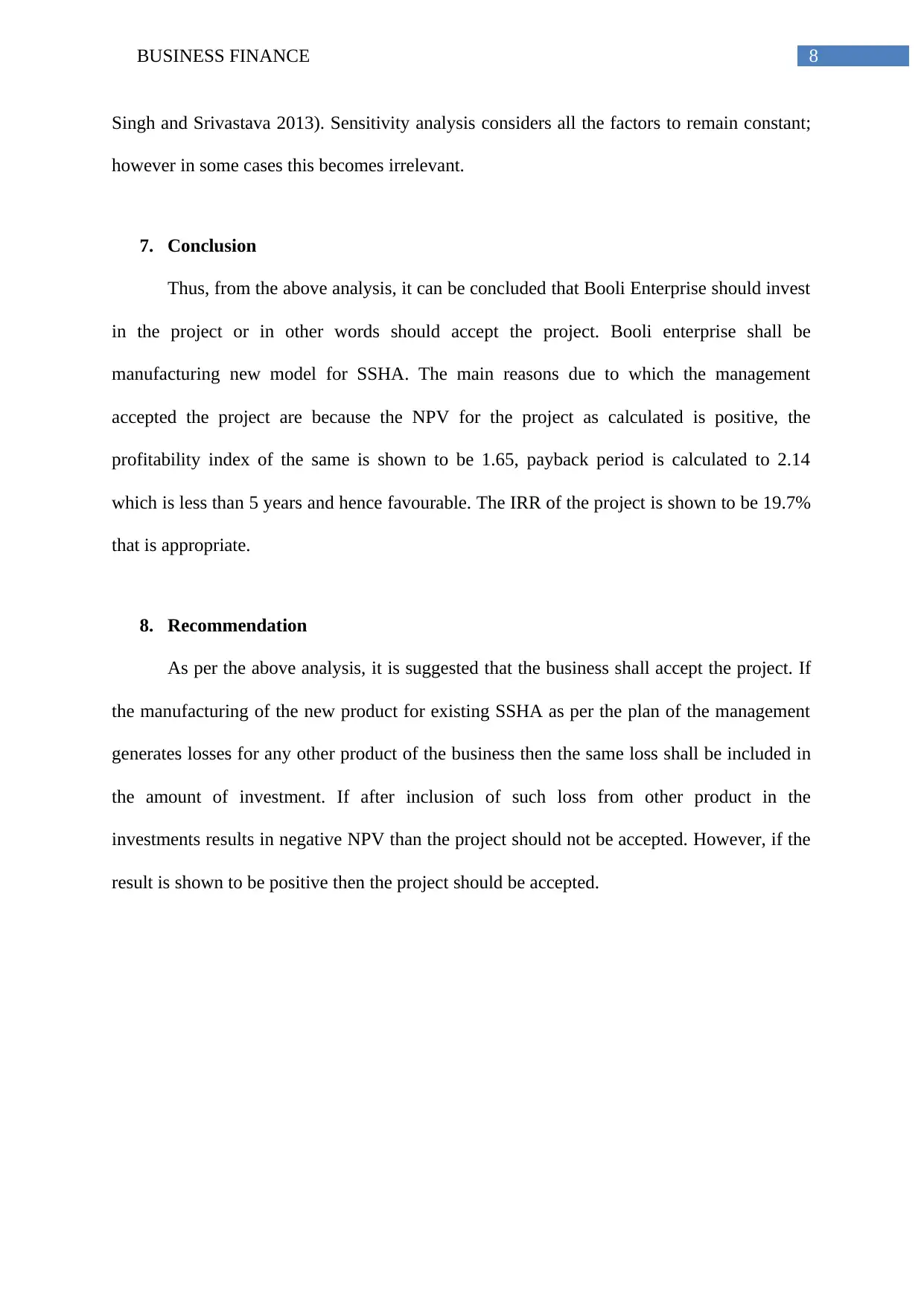
8BUSINESS FINANCE
Singh and Srivastava 2013). Sensitivity analysis considers all the factors to remain constant;
however in some cases this becomes irrelevant.
7. Conclusion
Thus, from the above analysis, it can be concluded that Booli Enterprise should invest
in the project or in other words should accept the project. Booli enterprise shall be
manufacturing new model for SSHA. The main reasons due to which the management
accepted the project are because the NPV for the project as calculated is positive, the
profitability index of the same is shown to be 1.65, payback period is calculated to 2.14
which is less than 5 years and hence favourable. The IRR of the project is shown to be 19.7%
that is appropriate.
8. Recommendation
As per the above analysis, it is suggested that the business shall accept the project. If
the manufacturing of the new product for existing SSHA as per the plan of the management
generates losses for any other product of the business then the same loss shall be included in
the amount of investment. If after inclusion of such loss from other product in the
investments results in negative NPV than the project should not be accepted. However, if the
result is shown to be positive then the project should be accepted.
Singh and Srivastava 2013). Sensitivity analysis considers all the factors to remain constant;
however in some cases this becomes irrelevant.
7. Conclusion
Thus, from the above analysis, it can be concluded that Booli Enterprise should invest
in the project or in other words should accept the project. Booli enterprise shall be
manufacturing new model for SSHA. The main reasons due to which the management
accepted the project are because the NPV for the project as calculated is positive, the
profitability index of the same is shown to be 1.65, payback period is calculated to 2.14
which is less than 5 years and hence favourable. The IRR of the project is shown to be 19.7%
that is appropriate.
8. Recommendation
As per the above analysis, it is suggested that the business shall accept the project. If
the manufacturing of the new product for existing SSHA as per the plan of the management
generates losses for any other product of the business then the same loss shall be included in
the amount of investment. If after inclusion of such loss from other product in the
investments results in negative NPV than the project should not be accepted. However, if the
result is shown to be positive then the project should be accepted.
⊘ This is a preview!⊘
Do you want full access?
Subscribe today to unlock all pages.

Trusted by 1+ million students worldwide
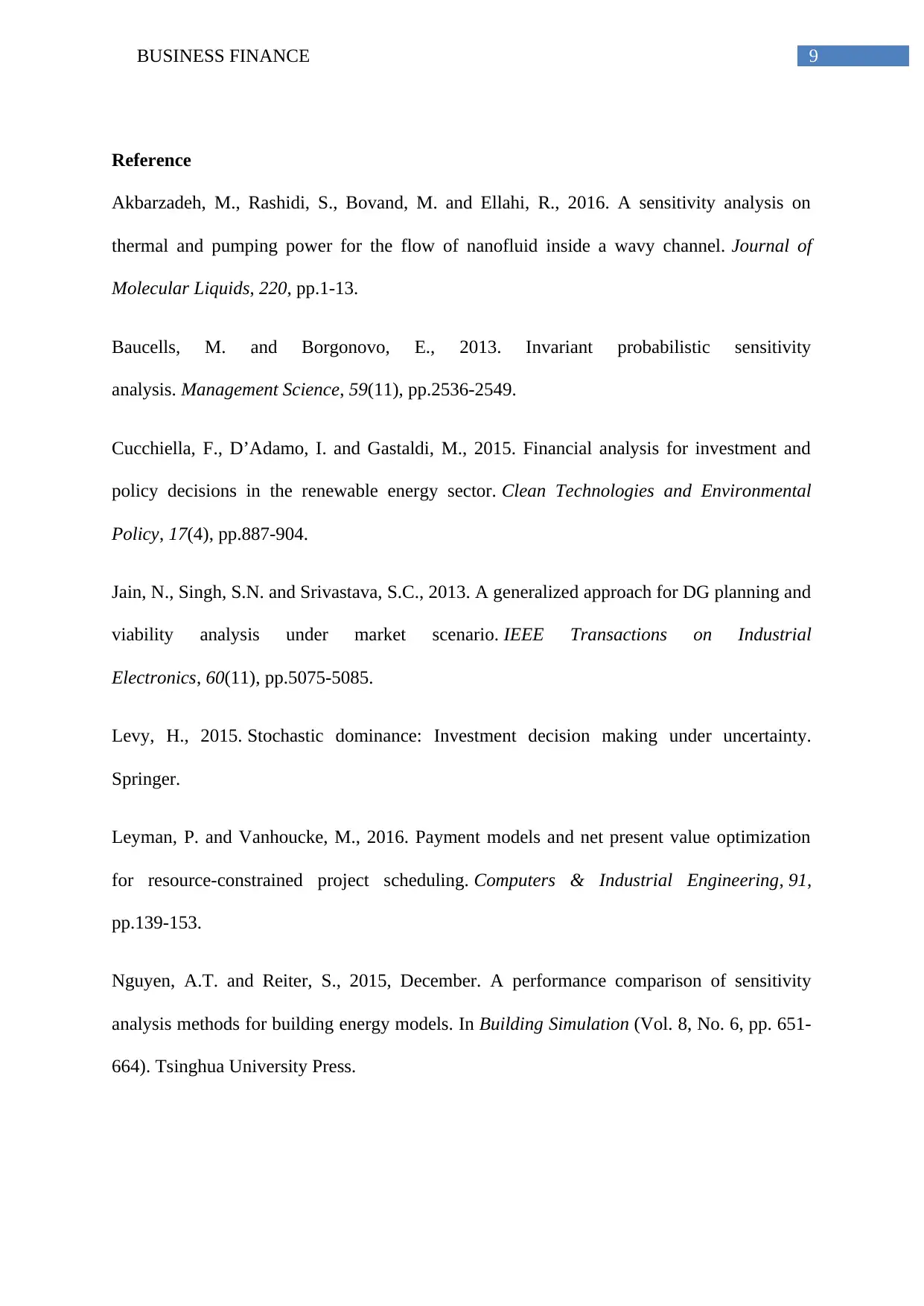
9BUSINESS FINANCE
Reference
Akbarzadeh, M., Rashidi, S., Bovand, M. and Ellahi, R., 2016. A sensitivity analysis on
thermal and pumping power for the flow of nanofluid inside a wavy channel. Journal of
Molecular Liquids, 220, pp.1-13.
Baucells, M. and Borgonovo, E., 2013. Invariant probabilistic sensitivity
analysis. Management Science, 59(11), pp.2536-2549.
Cucchiella, F., D’Adamo, I. and Gastaldi, M., 2015. Financial analysis for investment and
policy decisions in the renewable energy sector. Clean Technologies and Environmental
Policy, 17(4), pp.887-904.
Jain, N., Singh, S.N. and Srivastava, S.C., 2013. A generalized approach for DG planning and
viability analysis under market scenario. IEEE Transactions on Industrial
Electronics, 60(11), pp.5075-5085.
Levy, H., 2015. Stochastic dominance: Investment decision making under uncertainty.
Springer.
Leyman, P. and Vanhoucke, M., 2016. Payment models and net present value optimization
for resource-constrained project scheduling. Computers & Industrial Engineering, 91,
pp.139-153.
Nguyen, A.T. and Reiter, S., 2015, December. A performance comparison of sensitivity
analysis methods for building energy models. In Building Simulation (Vol. 8, No. 6, pp. 651-
664). Tsinghua University Press.
Reference
Akbarzadeh, M., Rashidi, S., Bovand, M. and Ellahi, R., 2016. A sensitivity analysis on
thermal and pumping power for the flow of nanofluid inside a wavy channel. Journal of
Molecular Liquids, 220, pp.1-13.
Baucells, M. and Borgonovo, E., 2013. Invariant probabilistic sensitivity
analysis. Management Science, 59(11), pp.2536-2549.
Cucchiella, F., D’Adamo, I. and Gastaldi, M., 2015. Financial analysis for investment and
policy decisions in the renewable energy sector. Clean Technologies and Environmental
Policy, 17(4), pp.887-904.
Jain, N., Singh, S.N. and Srivastava, S.C., 2013. A generalized approach for DG planning and
viability analysis under market scenario. IEEE Transactions on Industrial
Electronics, 60(11), pp.5075-5085.
Levy, H., 2015. Stochastic dominance: Investment decision making under uncertainty.
Springer.
Leyman, P. and Vanhoucke, M., 2016. Payment models and net present value optimization
for resource-constrained project scheduling. Computers & Industrial Engineering, 91,
pp.139-153.
Nguyen, A.T. and Reiter, S., 2015, December. A performance comparison of sensitivity
analysis methods for building energy models. In Building Simulation (Vol. 8, No. 6, pp. 651-
664). Tsinghua University Press.
Paraphrase This Document
Need a fresh take? Get an instant paraphrase of this document with our AI Paraphraser
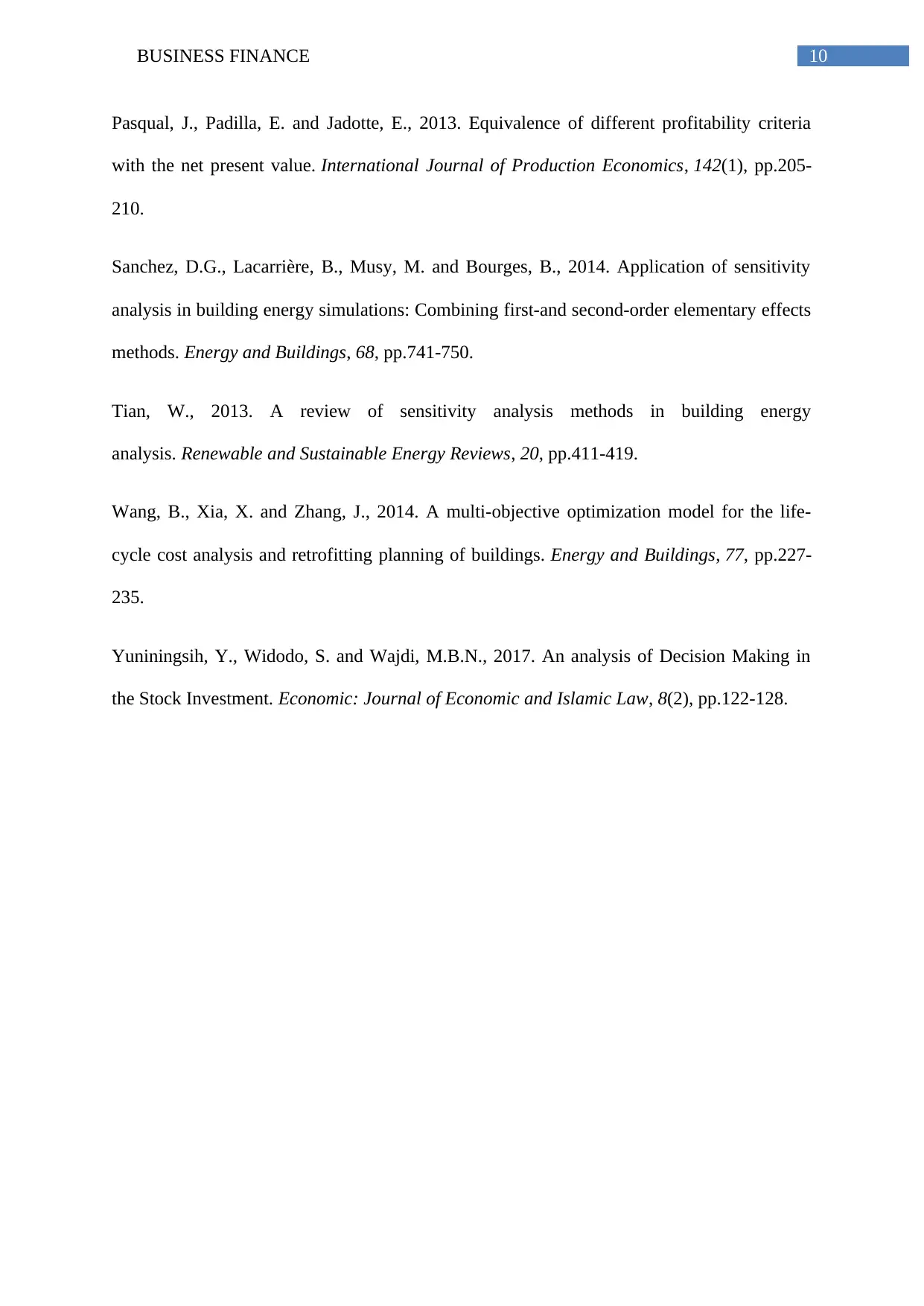
10BUSINESS FINANCE
Pasqual, J., Padilla, E. and Jadotte, E., 2013. Equivalence of different profitability criteria
with the net present value. International Journal of Production Economics, 142(1), pp.205-
210.
Sanchez, D.G., Lacarrière, B., Musy, M. and Bourges, B., 2014. Application of sensitivity
analysis in building energy simulations: Combining first-and second-order elementary effects
methods. Energy and Buildings, 68, pp.741-750.
Tian, W., 2013. A review of sensitivity analysis methods in building energy
analysis. Renewable and Sustainable Energy Reviews, 20, pp.411-419.
Wang, B., Xia, X. and Zhang, J., 2014. A multi-objective optimization model for the life-
cycle cost analysis and retrofitting planning of buildings. Energy and Buildings, 77, pp.227-
235.
Yuniningsih, Y., Widodo, S. and Wajdi, M.B.N., 2017. An analysis of Decision Making in
the Stock Investment. Economic: Journal of Economic and Islamic Law, 8(2), pp.122-128.
Pasqual, J., Padilla, E. and Jadotte, E., 2013. Equivalence of different profitability criteria
with the net present value. International Journal of Production Economics, 142(1), pp.205-
210.
Sanchez, D.G., Lacarrière, B., Musy, M. and Bourges, B., 2014. Application of sensitivity
analysis in building energy simulations: Combining first-and second-order elementary effects
methods. Energy and Buildings, 68, pp.741-750.
Tian, W., 2013. A review of sensitivity analysis methods in building energy
analysis. Renewable and Sustainable Energy Reviews, 20, pp.411-419.
Wang, B., Xia, X. and Zhang, J., 2014. A multi-objective optimization model for the life-
cycle cost analysis and retrofitting planning of buildings. Energy and Buildings, 77, pp.227-
235.
Yuniningsih, Y., Widodo, S. and Wajdi, M.B.N., 2017. An analysis of Decision Making in
the Stock Investment. Economic: Journal of Economic and Islamic Law, 8(2), pp.122-128.
1 out of 11